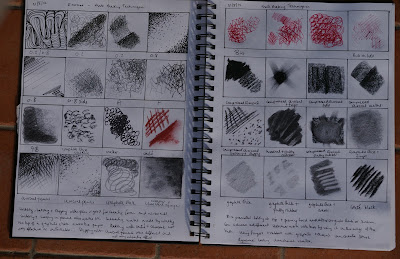Sketchbook 1 Pages 1- 19
Exercise: Holding Pens and Pencils
I'm very out of practice so this was a good exercise to get me back into the handling of drawing implements without the pressure to produce a work of art and also a good way to overcome the fear of a completely blank sketchbook.Holding the pencil near the end and dangling it onto the paper produced some nice expressive marks with the grainy texture of the paper showing through. It was quite difficult to accurately control the tip when drawing in this way. Holding the pencil near the tip gave finer control and varying the pressure meant the marks could get quite intense and strong. Using the 0.05 pigment liner held near the end produced very scratchy results which looked tentative. Holding near the tip produced a smoother line.
I particularly enjoyed doing the sweeping marks on large paper (especially with charcoal). I could put my whole arm into this and produced some strong gestural curves - nothing tentative there. This didn't work so well with the pigment liners as I was afraid of ruining their tips with the vigorous application.
I really liked the feel of the graphite sitcks on paper. They glide smoothly across the paper it's a lovely sensation through my hand. Varying the pressure with them allowed the grainy texture of the paper to show through.
Exercise: Doodling
I loved this - the freedom to play and experiment was liberating. I did have to really fight the temptation to try to produce a drawing though as my overly-analytical side kept trying to make sense of the doodles.Exercise: Mark- Making Techniques
Scribbling, hatching and stippling with pigment liners worked well and could be used to create form. Scribbling and hatching in pencil also worked well and a wide variety of marks could be produced. I made some interesting marks by walking the tip of a graphite stick across the paper. Hatching with conte' and thick charcoal sticks seemed very clumsy and I didn't like the results.When picking up the biro I found I automatically held it near the tip as if to write. This promoted pressing hard on the paper and the marks produced were quite aggressive. I found I could produce scratchy/sketchy marks with the biro by using it more on the side of the nib.
Compressed charcoal made a very intense dark tone when built up. Using a finger I could make strong directional marks coming out from an area of dark charcoal. I liked using the side of the compressed charcoal as the grain of the paper created an interesting texture and overlapping adjacent sweeps of charcoal allowed variations in tone. Lifting out charcoal or graphite with the putty rubber also produced interesting gradations in tone and directional marks.
 |
| 31.08.12 Exercise: Mark Making Techniques |
 |
| 31.08.12 Exercise: Mark Making Techniques |
I found the oil pastels very difficult to handle. They seemed to work best when colour was applied in thick layers.
Stippling with felt tip and marker allowed the mixing of colour and representation of form and tone but I couldn't produce a great variety of different lines with them. In contrast, a dip pen with ink lent it self well to producing many different types of marks and this could give it more potential than the drawing pens to be expressive.
Exercise: Using Charcoal
I love charcoal. I like anything inherently messy. I tried different thicknesses of willow charcoal as well as compressed charcoal. It was good for producing variations in tone and interesting textures with the grain of paper showing through. I especially liked the strong curves produced when I was making patterns with a piece of a charcoal stick on its side.
Charcoal would be good to use for tonal studies, particularly large scale drawings and gestural drawings. It isn't much good for small, fine details because of its tendency to smdge.
 |
| 01.09.12 Exercise: Using Charcoal |
 |
| 01.09.12 Exercise: Using Charcoal |
Exercise: Line and Other Marks
Pencil works best for tentative feathery marks and there is much more possible variation in intesity with this and graphite that there is with drawing pen. Ink can be used in a myriad of different ways. A dip pen can produce a large variety of lines ranging from very scratchy, pale impressions to very intense thick lines. I experimented with lots of ways of applying ink to the paper from a fork to a dry crust of stale bread and a scrunched up piece of kitchen roll. I especially liked the effect when I dipped a stick of willow charcoal into the ink and made rapid bold strokes. This produced gestural marks with a very intense deep accent at one end petering to a grainy texture at the other end.
 |
| 03.09.12 Exercise: Lines and Other Marks |
No comments:
Post a Comment